No. 3, Vol 1. Autumnal Equinox 2002
by Rawn Clark
At the heart of the Western understanding of the Tree of Life, is the little document titled "The 32 Paths of Wisdom". Usually, this document accompanies the English editions of the "Sepher Yetzirah" and is seen as an explanation or clarification of the S.Y. However, the concept of 32 Paths of Wisdom stems, not from the S.Y., but from the Torah, Genesis, Chapter One.[1] Furthermore, the document "32 Paths of Wisdom" comes to us from the late 13th Century, C.E.[2] - centuries before the advent of the Western image of the Tree.
According to the Jewish tradition, the 32 Paths of Wisdom concept is derived from the 32 times that the name "Elohim" is mentioned in Genesis, Chapter One.
Sephiroth: "Elohim said:" *
Kether -- "In the beginning Elohim created the heavens and the earth."
1:1*
Chokmah -- "Let there be light" 1:3
Binah -- "Let there be a firmament . . . let it divide . . ."
1:6
Gedulah -- "Let the waters be gathered . . . let dry land appear
. . ." 1:9
Geburah -- "Let the earth put forth grass . . . etc." 1:11
Tiphareth -- "Let there be lights in the firmament . . ." 1:14
Netzach -- "Let the waters swarm . . . let fowl fly . . ." 1:20
Hod -- "Let the earth bring forth living creatures . . ." 1:24
Yesod -- "Let us make man . . ." 1:26
Malkuth -- "Be fruitful and multiply . . ." 1:28
Mothers: "Elohim made:"
Aleph -- "the Firmament and divided the waters . . ." 1:7
Mem -- "the two great lights . . . and the stars." 1:16
Shin -- "the beast of the earth after its kind . . ." 1:25
Doubles: "Elohim saw:"
Beth -- "the light, that it was good." 1:4
Gimel -- "that it was good." (the separation of dry land and
waters) 1:10
Daleth -- "that it was good" (the earth bringing forth grass,
etc.) 1:12
Kaph -- that it was good" (the two lights in the firmament) 1:18
Peh -- "that it was good" (swarming of waters with creatures;
of air with fowl) 1:21
Resh -- "that it was good" (the beasts of the earth) 1:25
Tav -- "every thing that He had made, and, behold, it was very good."
1:31
Elementals: "Elohim --"
Heh -- "hovered over the face of the waters." 1:2
Vav -- "divided the light from the darkness." 1:4
Zayin -- "called the light Day, and darkness Night." 1:5
Cheth -- "called the firmament Heaven." 1:8
Teth -- "called the dry land, Earth . . . and the waters, Seas."
1:10
Yod -- "set them [the two lights] in the firmament of the heaven"
1:17
Lamed -- "created the sea-monsters, creatures that creep, and fowl."
1:21
Nun -- "blessed them [sea-monsters, creepers, and fowl] . . ."
1:22
Samekh -- "created man in His own image." 1:27
Ayin -- "created He him; male and female created He them." 1:27
Tzaddi -- "blessed them [male and female]." 1:28
Qooph -- "said: I have given you all . . ." 1:29*
*There are two exceptions to this: The first is Gen1:1, and Sephirah 1/Kether, wherein "Elohim said" is assumed. The second is Gen1:29, and Elemental 12/Qooph, wherein the focus is shifted from the "Elohim said", to the "I have given you all . . ."
The Sepher Yetzirah (circa 1st Century, B.C.E.) incorporates and seeks to explain these 32 Paths of Genesis. The "32 Paths of Wisdom" document however, was written about 1,400 years after the S.Y. and speaks of these 32 Paths in the context of the S.Y.'s Tree of Life.
At the time that the "32 Paths" document was written, the Tree of Life looked a bit different than the Western Hermetic Tree. It was an ostensibly Jewish Tree that followed the strict rules laid down in the Sepher Yetzirah, whereas the Western Tree follows a different set of rules. Yet modern Western kabbalists have interpreted the "32 Paths" document based upon the Western Tree and not upon the 13th Century Jewish Tree. Which, of course, generates a significantly different understanding of the 32 Paths than is held by Jewish kabbalah.
This becomes an important issue when it comes to a reverse investigation and interpretation of the S.Y. and the "32 Paths" document using the Western Tree as the basis for one's reasoning. Instead of trying to understand the Tree by first understanding its roots, many Western writers have sought to understand the roots by comparing them to the Western Tree. The problem is that the Western Tree has grown too far from its root for this to net an accurate understanding.
So let's do a little back tracking and take a look at how the "32 Paths of Wisdom" document looks when it's applied to the Tree that was prevalent when it was originally written.
According to recent scholarship, the author of the "32 Paths" document was a member of the 13th Century Castilian conclave of kabbalistic writers known as the "Circle of Contemplation".[3] Their primary influences were the Torah, S.Y. and Bahir, and the image of the Tree they would have employed was what I call the "Hebrew Tree".[4]
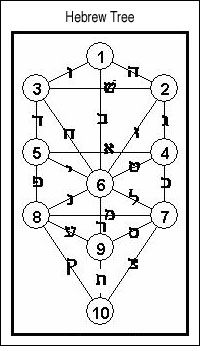
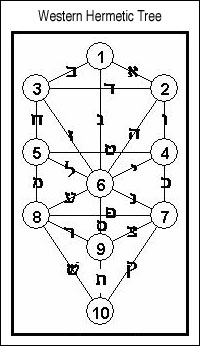
In the Jewish tradition of the 32 Paths of Wisdom, the Paths and their correspondences are established by the sequence of Genesis, Chapter One. Naturally, this was the sequence used by the author of the "32 Paths" document and results in the following set of relationships:
| Jewish Tradition | (Western Tradition) |
| Path #1 = Kether 1:1 | (=Kether) |
| Path #2 = Heh 1:2 | (=Chokmah) |
| Path #3 = Chokmah 1:3 | (= Binah) |
| Path #4 = Beth 1:4 | (= Gedulah) |
| Path #5 = Vav 1:4 | (= Geburah) |
| Path #6 = Zayin 1:5 | (= Tiphareth) |
| Path #7 = Binah 1:6 | (= Netzach) |
| Path #8 = Aleph 1:7 | (= Hod) |
| Path #9 = Cheth 1:8 | (= Yesod) |
| Path #10 = Gedulah 1:9 | (= Malkuth) |
| Path #11 = Teth 1:10 | (= Aleph) |
| Path #12 = Gimel 1:10 | (= Beth) |
| Path #13 = Geburah 1:11 | (= Gimel) |
| Path #14 = Daleth 1:12 | (= Daleth) |
| Path #15 = Tiphareth 1:14 | (= Heh) |
| Path #16 = Mem 1:16 | (= Vav) |
| Path #17 = Yod 1:17 | (= Zayin) |
| Path #18 = Kaph 1:18 | (= Cheth) |
| Path #19 = Netzach 1:20 | (= Teth) |
| Path #20 = Lamed 1:21 | (= Yod) |
| Path #21 = Peh 1:21 | (= Kaph) |
| Path #22 = Nun 1:22 | (= Lamed) |
| Path #23 = Hod 1:24 | (= Mem) |
| Path #24 = Shin 1:25 | (= Nun) |
| Path #25 = Resh 1:25 | (= Samekh) |
| Path #26 = Yesod 1:26 | (= Ayin) |
| Path #27 = Samekh 1:27 | (= Peh) |
| Path #28 = Ayin 1:27 | (= Tzaddi) |
| Path #29 = Tzaddi 1:28 | (= Qooph) |
| Path #30 = Malkuth 1:28 | (= Resh) |
| Path #31 = Qooph 1:29 | (= Shin) |
| Path #32 = Tav 1:31 | (= Tav) |
As you can see, at this level there are only three points of similarity (Paths #1, #14 and #32) out of 32. However, this is only at the level of Paths-to-Letters/Sephirot. When we add in the differences in the image of the Tree of Life, these dissimilarities are magnified even more:
| Hebrew Tree | (Western Tree) |
| Path #1 = Kether, Sephirah 1 | (= Kether, Sephirah 1) |
| Path #2 = Heh, 1>2 | (= Chokmah, Sephirah 2) |
| Path #3 = Chokmah, Sephirah 2 | (= Binah, Sephirah 3) |
| Path #4 = Beth , 1>6 | (= Gedulah, Sephirah 4) |
| Path #5 = Vav, 1>3 | (= Geburah, Sephirah 5) |
| Path #6 = Zayin, 2>6 | (= Tiphareth, Sephirah 6) |
| Path #7 = Binah, Sephirah 3 | (= Netzach, Sephirah 7) |
| Path #8 = Aleph, 4>5 | (= Hod, Sephirah 8) |
| Path #9 = Cheth, 3>6 | (= Yesod, Sephirah 9) |
| Path #10 = Gedulah, Sephirah 4 | (= Malkuth, Sephirah 10) |
| Path #11 = Teth, 4>6 | (= Aleph, 1>2) |
| Path #12 = Gimel, 2>4 | (= Beth, 1>3) |
| Path #13 = Geburah, Sephirah 5 | (= Gimel, 1>6) |
| Path #14 = Daleth, 3>5 | (= Daleth, 2>3) |
| Path #15 = Tiphareth, Sephirah 6 | (= Heh, 2>6) |
| Path #16 = Mem, 7>8 | (= Vav, 2>4) |
| Path #17 = Yod, 5>6 | (= Zayin, 3>6) |
| Path #18 = Kaph, 4>7 | (= Cheth, 3>5) |
| Path #19 = Netzach, Sephirah 7 | (= Teth, 4>5) |
| Path #20 = Lamed, 6>7 | (= Yod, 4>6) |
| Path #21 = Peh, 5>8 | (= Kaph, 4>7) |
| Path #22 = Nun, 6>8 | (= Lamed, 5>6) |
| Path #23 = Hod, Sephirah 8 | (= Mem, 5>8) |
| Path #24 = Shin, 2>3 | (= Nun, 6>7) |
| Path #25 = Resh, 6>9 | (= Samekh, 6>9) |
| Path #26 = Yesod, Sephirah 9 | (= Ayin, 6>8) |
| Path #27 = Samekh, 7>9 | (= Peh, 7>8) |
| Path #28 = Ayin, 8>9 | (= Tzaddi, 7>9) |
| Path #29 = Tzaddi, 7>10 | (= Qooph, 7>10) |
| Path #30 = Malkuth, Sephirah 10 | (= Resh, 8>9) |
| Path #31 = Qooph, 8>10 | (= Shin, 8>10) |
| Path #32 = Tav, 9>10 | (= Tav, 9>10) |
From this perspective, there are only two points of complete agreement: Path #1 = Kether and Path #32 = Tav, 9>10. There are also four points of partial agreement. Three of these four are Path #25 = 6>9, Path #29 = 7>10, and Path #31 = 8>10, but these three points do not agree upon which Letter belongs to these connections between Sephirot. The fourth point of partial agreement is the attribution of Daleth to Path #14, but here there is disagreement as to which two Sephirot Daleth connects (3>5 vs. 2>3).
The practical significance of these differences and their implication so far as kabbalistic understanding doesn't become truly apparent until we factor in the text of the "32 Paths" document itself. To illustrate briefly, here's the same list but with the addition of the "intelligences" or "consciousnesses" of each Path:
| Hebrew Tree | Intelligence | (Western Tree) |
| Path #1 = Kether, Sephirah 1 | Mystical | (= Kether, Sephirah 1) |
| Path #2 = Heh, 1>2 | Illuminating | (= Chokmah, Sephirah 2) |
| Path #3 = Chokmah, Sephirah 2 | Sanctifying | (= Binah, Sephirah 3) |
| Path #4 = Beth , 1>6 | Overflowing | (= Gedulah, Sephirah 4) |
| Path #5 = Vav, 1>3 | Root | (= Geburah, Sephirah 5) |
| Path #6 = Zayin, 2>6 | Transparent | (= Tiphareth, Sephirah 6) |
| Path #7 = Binah, Sephirah 3 | Hidden | (= Netzach, Sephirah 7) |
| Path #8 = Aleph, 4>5 | Perfect | (= Hod, Sephirah 8) |
| Path #9 = Cheth, 3>6 | Pure | (= Yesod, Sephirah 9) |
| Path #10 = Gedulah, Sephirah 4 | Resplendent | (= Malkuth, Sephirah 10) |
| Path #11 = Teth, 4>6 | Scintillating | (= Aleph, 1>2) |
| Path #12 = Gimel, 2>4 | Transparent | (= Beth, 1>3) |
| Path #13 = Geburah, Sephirah 5 | Unifying | (= Gimel, 1>6) |
| Path #14 = Daleth, 3>5 | Luminous | (= Daleth, 2>3) |
| Path #15 = Tiphareth, Sephirah 6 | Constituting | (= Heh, 2>6) |
| Path #16 = Mem, 7>8 | Eternal | (= Vav, 2>4) |
| Path #17 = Yod, 5>6 | Disposition | (= Zayin, 3>6) |
| Path #18 = Kaph, 4>7 | Influence | (= Cheth, 3>5) |
| Path #19 = Netzach, Sephirah 7 | Secret of allSpiritual Activity | (= Teth, 4>5) |
| Path #20 = Lamed, 6>7 | Will | (= Yod, 4>6) |
| Path #21 = Peh, 5>8 | Fulfilled Desire | (= Kaph, 4>7) |
| Path #22 = Nun, 6>8 | Faithful | (= Lamed, 5>6) |
| Path #23 = Hod, Sephirah 8 | Stable | (= Mem, 5>8) |
| Path #24 = Shin, 2>3 | Imaginative | (= Nun, 6>7) |
| Path #25 = Resh, 6>9 | Trial | (= Samekh, 6>9) |
| Path #26 = Yesod, Sephirah 9 | Renewing | (= Ayin, 6>8) |
| Path #27 = Samekh, 7>9 | Exciting | (= Peh, 7>8) |
| Path #28 = Ayin, 8>9 | Natural | (= Tzaddi, 7>9) |
| Path #29 = Tzaddi, 7>10 | Corporealizing | (= Qooph, 7>10) |
| Path #30 = Malkuth, Sephirah 10 | Universal | (= Resh, 8>9) |
| Path #31 = Qooph, 8>10 | Perpetual | (= Shin, 8>10) |
| Path #32 = Tav, 9>10 | Serving | (= Tav, 9>10) |
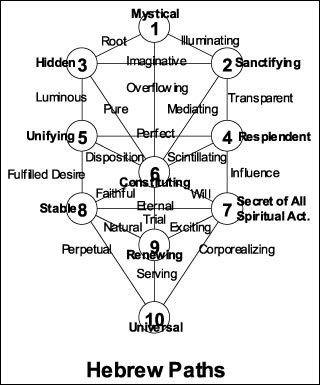
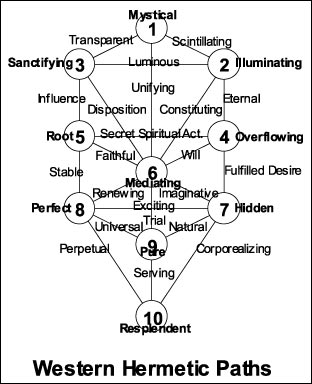
In my experience, the differences between the Jewish and Western understandings of the Tree of Life are too vast to bridge except through the imagery of the Tarot major arcana. By using these images, along with their Western tradition of Hebrew Letter correspondences, and fitting them to the Hebrew Tree, a Western practitioner can come to a better understanding of the Hebrew Tree and by extension, the Jewish kabbalah.
To that end, I invite you to experiment with the following correspondences in your sphere - and pathworking. Below, you will find the text of the "32 Paths of Wisdom" document, juxtaposed with their Hebrew Tree correspondences and their Tarot Arcanum[5] (where appropriate). I've also included Paul Case's "Pattern on the Trestleboard" statements for each Sephira; and for the planetary Sephirot, I've included the Temple images from my own "Eight Temples Meditation Project".[6] Along side all of this, you will find my own personal commentary.
I've arranged the Paths in what I call an "initiatory sequence". Initiation is a process of the ascent, expansion and integration of consciousness. It begins at the basest personal level of consciousness (Malkuth) and spans the gamut to the Unity of All consciousness (Kether). The Tree of Life expresses this essential process and defines ten stages or levels of initiation, corresponding to the Sephirot. It also defines a sequential path of ascent that integrates all ten of these levels.
By applying the purely Western techniques of sphere - and pathworking to the Hebrew Tree, and using the "32 Paths of Wisdom" document combined with the Tarot major arcana as our illustrated tour guide, a cogent system of self-initiation emerges.
Sphereworking (i.e., experiencing the Sephirot) should precede pathworking. This bias is reflected in the sequence I present here. We begin with Malkuth, followed by Yesod - as sphereworkings. Only then do we pursue the first initiatory path, Tav 9>10 - as a pathworking beginning in Yesod and ending in Malkuth.
In this form of initiatory working upon the Tree, pathworking is reserved for integration of the newly attained level of consciousness and not as a means of ascent proper. However, working the paths that depend from a newly attained sphere is part of the process that enables the initiate to ascend to the next higher level. In other words, the integration of the new level into the old level(s), through pathworking, is what transforms the initiate and empowers their next ascent.
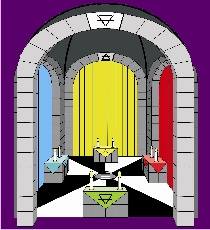 Malkuth:
Sephirah #10
Malkuth:
Sephirah #10
#10: The Kingdom of spirit is embodied in my flesh.
Path #30 - "The thirtieth path is called the universal consciousness because through it, masters of the heavens derive their judgments of the stars and constellations, and perfect their knowledge of the celestial cycles."
Above all else, the "32 Paths" document describes the work to be done in relation to each Path. Here we are told that the work of Malkuth is self-analysis which leads to self-knowledge.
The analogy used is that of an astrologer ("master of the heavens") who looks to the movements and positions of the planets ("stars") within the zodiac ("constellations") in order to comprehend the universal forces at play in any given moment. The work of self-analysis is much the same in that one examines the manifest personality and from that, derives certain truths about the universal forces that underlie the personality traits and the general structure of personality itself. In symbolic terms, the planets represent the basic components of the personality and the zodiacal signs represent the Elemental structure of personality. Thus this self-analysis is performed in the context of the four Elements and each aspect of the personality is assigned an Elemental correspondence.
This analysis of the inner self and of the external universe is the first step along the path of initiation. In essence, it is a process of judging cause by examining its effect - of trying to understand what is reflected by gazing at a mirror instead of looking directly at the source. The rationale behind this tact is that each material manifestation is an expression of a Universal force. By observing the material manifestation one can, by extension, learn something about the Universal force that causes it. For example, an astrologer looks to the position of a planet within the zodiac and from that derives an indication of what subtle influences are affecting human affairs, but the astrologer is basing this judgment upon the characteristics of the manifestation or end result, not upon the direct perception of the Universal force itself. With this knowledge in hand however, the astrologer can predict behavior and can, to a certain extent, compensate for the subtle influence.
And so it is with the work of Malkuth. By analyzing the inner and outer manifestation, the initiate learns to recognize the subtle influences that affect them and comes to see that indeed, the kingdom of spirit is embodied in their flesh.
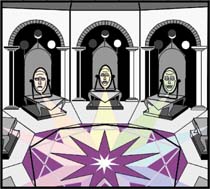 Yesod: Sephirah
#9
Yesod: Sephirah
#9
#9: In thought and word and deed, I rest my life from day to day upon the sure Foundation of eternal being.
Path #26 - "The twenty-sixth path is called the renewing consciousness because through it God, blessed be He, renews all things which are newly begun in the creation of the world."
Yesod is the Middle Pillar root of the astral personality. In human terms it is the (predominantly subconscious) psyche. The work of Yesod is the application of the Malkuth self-knowing toward self-transformation. This is the renewal of the "small self" or personality, where "every thought, word and deed" is dedicated to transforming the personality so that it truly reflects the "eternal being". In Yesod, the initiate stands as the source of reflection and consciously casts their image upon the mirror of manifest personality, constantly reshaping their projection until the reflection matches their inner light. This is expressed clearly in the corresponding Genesis passage:
Genesis 1:26 - "And Elohim said: 'Let us make man in our image, after our likeness; and let them have power over the fish of the sea, and over the fowl of the air, and over the cattle, and over all the earth, and over every creeping thing that creepeth upon the earth.'"
"Man" in this case is the astral personal self, who exercises power over the Elements ("sea", "air", and "earth") and all their manifestations within the realm of the personality and life circumstance. The conscious exercising of this power-over the personality, causes a "renewal" within the initiate's psyche.
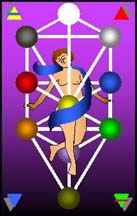 Tav: 9>10
Tav: 9>10
Path #32 - "The thirty-second path is called the serving consciousness because it directs the motion of the seven planets, each in its own proper course."
Tav describes the task of Yesod - namely, the conscious impressing upon Malkuth (our material life circumstance) of the renewed Yesodic personality. In the symbolism of the "32 Paths" this is described as the conscious directing of the "seven planets" (i.e., the aspects of the personality) in their "proper" course. Their "proper" course is represented in the Tarot imagery as occurring within the context of the balanced four Elements (i.e., the cherubic signs of the zodiac).
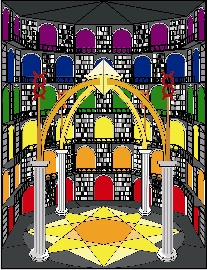 Hod:
Sephirah #8
Hod:
Sephirah #8
#8: I look forward with confidence to the perfect realization of the Eternal Splendor of the limitless light.
Path #23 - "The twenty-third path is called the stable consciousness because it is the power of sustenance among all the Sephirot."
As the work of self-transformation of the personality progresses, the initiate comes to see that the personality exists between two poles - rationality or logic, and emotion or instinct. In kabbalah, these poles are symbolized by Hod (rational intellect) and Netzach (instinctual emotion). Along the ascending path of initiation (as opposed to the descending path of creation), the first of these poles that the initiate encounters is the rational intellect, represented by Hod. The work of Hod therefore, is to pursue a rational understanding of the dynamics operative within the inner and outer worlds. This leads to the vision of the "Eternal Splendor" and the infinite complexity of the Universe, symbolized here by the "Library of Hermes" which contains rational information about every aspect of existence.
The "32 Paths" text states that this is the "power of sustenance among all the Sephirot". To understand how this is so, we must refer to the Genesis passage from which the 23rd Path is derived.
Genesis 1:24 - "And Elohim said: 'Let the earth bring forth the living creature after its kind, cattle and creeping things, and beast of the earth after its kind.' And it was so."
The specific phrasing of this passage holds the key. Here we see that Elohim is letting the earth bring forth these things, out of its own substance, as opposed to Elohim creating these things out of nothingness. This indicates a sequential process of self-sustaining self-propagation as opposed to direct creation. It expresses the mechanism of infinite complexity as one thing begets another, endlessly creating subtle shades of difference between the generations. This mechanism fills and thus stabilizes the sequential infinity, and can be seen within the kabbalistic doctrine of emanation at every level of the Tree.
Hod is the terminus of the Pillar of Severity or Form. In the language of the "32 Paths" the Pillar of Severity is the receptacle of the "substance of the Unity", whereas the opposite side-pillar (Mercy or Force) is the receptacle of the "splendor of the Unity" and the Middle Pillar, the receptacle of the "holy powers". In Hod, as Paul Case stated, we "realize" the splendor of the opposite pillar, but this is different from the actual experience of that splendor. Here in Hod, the splendor is seen with the rational mind alone, as it appears reflected through infinite complexity. Thus it is not experienced in its wholeness as a more-than-rational force. In other words, in Hod we come to a rational understanding of the infinite complexity in much the same way as we came to understand our personalities in Malkuth - by analyzing their manifestations.
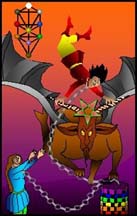 Ayin: 8>9
Ayin: 8>9
Path #28 - "The twenty-eighth path is called the natural consciousness. Through it is completed the nature of all that exists beneath the sphere of the sun."
In Hod, we learn the lesson that how and what we think, shapes our reality. With the path of Ayin, we apply that understanding to the transformation of our personality. The Tarot imagery depicts the natural mechanism that, when left as an unconscious process, binds the personality to the whims of subconscious reaction. Initiation however, demands more of us. It demands that we take this natural mechanism and use it consciously in the work of self-transformation of the personality.
The "32 Paths" passage speaks directly to this, stating that the action of the rational mind is what "completes" the astral matrix or personality. The term "beneath the sphere of the sun" refers to the Sephirot Netzach, Hod, Yesod and Malkuth - the lower astral realm of the personal self. Thus with Ayin, the initiate's task is that of consciously applying their rational understanding of things to the realm of their personality, with the unrelenting aim of transforming it into a closer semblance of their truest Self.
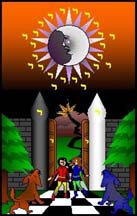 Qooph:
8>10
Qooph:
8>10
Path #31 - "The thirty-first path is called the perpetual consciousness. Why is it called this? Because it directs the movements of the sun and moon according to their natural order, each in its proper orbit."
With the path of Tav, connecting Yesod to Malkuth, the "32 Paths" text mentioned directing the motion of "the seven planets, each in its own proper course", but here we have "the sun and moon according to their natural order, each in its proper orbit." The sun is the primary planet of the Individual Self (Tiphareth) and the moon, that of the personal self (Yesod). Thus we see here a more refined sort of direction being imposed, relating to the Individual Self and the personality as whole things which interact. Whereas with Tav, the directing concerned the internal components of the personality alone (the seven planets).
"Qooph" translates into English roughly as "back of the head" and as a symbol, refers to the subconscious mind. In the Western Tree, the path of Qooph is placed on the opposite side and connects Netzach with Malkuth, expressing the concept that the subconscious mind is more closely related to the chaotic instinctual emotions than it is to the ordered rational mind. However, in the "32 Paths" and the Hebrew kabbalah in general, the subconscious mind is seen as the interaction of both ration and instinct, but shaped most immediately by our thinking. In other words, it's our thinking that gives form to the force of instinctual emotion. It is how we complexify the simpler instinct and create our own little manifestation of the infinitely complex Eternal Splendor (Hod).
The task of Qooph then, is to apply the rational understanding gained in Hod to the transformation of one's life circumstances (Malkuth). In effect, the initiate takes conscious control of their subconscious mind. The Tarot image depicts this process in reverse, indicating a journey upwards from Malkuth along the winding path of the subconsciousness which leads to the sun and moon in their "proper orbit". The task of Qooph however, is to descend along this "natural order" and consciously "direct" the motion (i.e., manifestation) of the interaction between Individual Self and personal self.
When this task is complete, the initiate will have integrated their rational Hod understanding into both Yesod and Malkuth - the personality and life circumstance. This prepares the initiate for their rise to the next level of the personal self - Netzach and the realm of emotional archetypes.
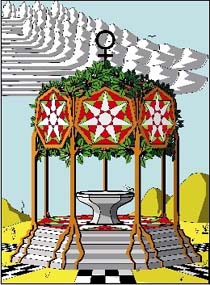 Netzach:
Sephirah #7
Netzach:
Sephirah #7
#7: Living from that Will, supported by its unfailing Wisdom and Understanding, mine is the Victorious Life.
Path #19 - "The nineteenth path is the consciousness of the secret of all spiritual activities. It is so called because of the influence disseminated by it from the highest blessing and the supernal glory."
Our rational mind reacts to, and interprets, instinct. For example, when we encounter something, our first reaction is at a pre-rational, emotional gut level. It is immediate and spontaneous and we have no conscious control over it. Our ration then takes over and modifies the primary emotional response, crafting it into a more personal form. Generally, our ration focuses not on the something we've encountered in and of itself, but upon the force of our own primary response. Another way of putting it would be to say that the primary emotional response is generally the force which ignites the ration to action - the action of ration being the giving of form to emotion.
Within the structure of the personality or lower astral body, Netzach is the pre-rational, instinctual gut reaction. The work of Netzach therefore, is to look within the rational reaction and penetrate to the initial gut-level instinct. In other words, to experience the force that ignites ration. This force is the "secret of all spiritual activities" because the direct perception of this force is what enables the completion of the transformation of the personal self.
This force is referred to in the path description as an "influence disseminated by it from the highest blessing and the supernal glory". In the symbol language of the "32 Paths", this is the "splendor of the Unity" emanated from Kether (the supernal glory) unto Chokmah by the path Heh. This splendor becomes Truth (Amen) within Chokmah and then descends unto Chesed/Gedulah via the path of Gimel as pure thought (Transparent Consciousness) where it becomes Loving Kindness. From there it descends into Netzach via the path of Kaph as "Arcanum and veiled ideas". So what we encounter in Netzach are these veiled ideas whose root is the splendor of the Unity.
Netzach is usually perceived as the realm of emotional archetypes and is symbolized by Venus, the goddess of love (quite fitting for the terminus of the Pillar of Mercy or Loving Kindness). In Netzach, one seeks out encounters with the astral images of these emotional archetypes and attempts to penetrate beyond the normal rational reaction in order to reach the direct experience of these forces themselves.
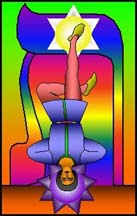 Mem:
7>8
Mem:
7>8
Path #16 - "The sixteenth path is called the eternal consciousness because it is the pleasure of that glory beyond which is no-glory like unto it. It is also called the garden of pleasure (Eden), which is prepared for the compassionate (Khasidim)."
This is the first horizontal path encountered as one rises up the Tree and it represents a significant experience for the budding initiate. Here, the initiate's task is to consciously combine instinctual emotion with rational response. Instead of following the normal path of this being a subconscious, habitual mechanism, one empowers it consciously and predicates their rational response upon the direct perception of the force which naturally ignites it. In relation to the normal function of human consciousness, this turns one's perspective topsy-turvy and up becomes down, left becomes right, etc.
This has a deeply transformative effect upon the rational mind, described in the "32 Paths" text as "the pleasure of that glory beyond which is no-glory like unto it".
Mem is the Mother Letter corresponding to the Element Water (the solidifying influence). In the structure of the Tree, Mem represents the lower astral manifestation of the "Plan of the Primordial", whose mental manifestation is seen in the path Aleph (Mother Letter of Air, the mediating influence) and whose supernal manifestation is seen in the path Shin (Mother Letter of Fire, the volatile influence). Each of these Mother Letters is attributed to a horizontal path that connects the two side pillars. In other words, they are stabilizing factors, essential to the overall equilibrium of the structure.
Each Mother Letter also defines a veil. Mem is the astral veil which hides the more essential mental reality by dressing it in a clothing of symbol. Aleph is the mental veil which hides the non-sequential supernal reality by dressing it in a clothing of sequentialized thought. And Shin is the supernal veil which hides the essential Unity by dressing it in a clothing of non-sequential duality.
Conversely, these veils also act as filters which distort or refract the descending creative influence. Shin refracts the Unity into non-sequential duality; Aleph refracts the duality into sequential thoughts; and Mem refracts sequential thought into dense astral symbol.
With the path of Mem, the initiate is faced with the task of walking this veil, exploring its natural mechanisms and employing them consciously.
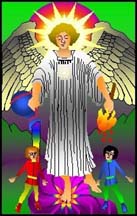 Samekh:
7>9
Samekh:
7>9
Path #27 - "The twenty-seventh path is called the exciting consciousness because, through it, is created the life-breath of every created being under the supreme orb, as well as the motion of them all."
The direct emotional forces that underlie the aspects of the personality serve as their "life-breath". With the path of Samekh, the initiate's task is to consciously shape the aspects of their personality through the direct application of this life-breath. This comes after the transformative Mem work of integrating ration and instinct, and one thus employs a balanced force (well illustrated by the Tarot image) in this aspect of self-transformation.
The path description refers to "every created being under the supreme orb, as well as the motion of them all". In the specific symbol language of the "32 Paths", this indicates the planets of the personality which, astrologically speaking, exist "under" the orbit of the sun (the supreme orb, from the perspective of the personal self). Thus the work of Samekh has the effect of enlivening these archetypal aspects of the personality and setting them in motion.
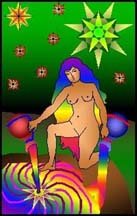 Tzaddi:
7>10
Tzaddi:
7>10
Path #29 - "The twenty-ninth path is called the corporeal consciousness because it marks out the forms and reproduction of all bodies which are incorporated under every cycle of the heavens."
The work of Tzaddi marks the completion of the initial phase in the transformation of the personal self. Here, the task is to integrate the perception of the instinctual emotional forces directly into one's daily life circumstances (i.e., to corporealize them). As the Tarot image implies, this brings the initiate into closer alignment with nature's own fluid mechanisms of corporealization.
The Hebrew word "Tzaddi" translates into English as "fish hook". Symbolically, this is what captures the "fish" of Qooph (Pisces), the subconscious mind. In Hebrew symbolism, the fish is a sign of fertility, so what we have here with Tzaddi is the capturing or hooking of the fertility of the subconscious mind. With it, the initiate feeds, sustains and nurtures the personality, and anchors it in the material life circumstances.
This final step illumines the personality and allows it to more clearly expresses the solar light of the Individual Self (Tiphareth). It is this illumination of the personal self that empowers the ensuing rise to a direct cognizance of the Individual Self. Without this firm foundation from which to rise, a direct cognizance of the Individual Self is, at best, temporary, incomplete and unstable.
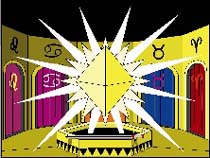 Tiphareth:
Sephirah #6
Tiphareth:
Sephirah #6
#6: In all things great and small, I see the Beauty of the divine expression.
Path #15 - "The fifteenth path is called the constituting consciousness because it constitutes the essence of creation in pure darkness. According to masters of contemplation, this is that darkness referred to in scripture: 'and thick darkness its swaddling band.'"
Having completed the work of transforming the personality into a conscious expression of one's understanding of the true self, it is almost inevitable that the initiate will rise to Tiphareth and experience the perspective of the Individual Self. This "Individual perspective" confers a sense of detachment and objectivity in regard to one's own personality and material life circumstance. From this perspective, the initiate looks "downward" at their mundane life and "outward" toward all the other Individual Selves that inhabit this level of the astral realm. One sees and directly experiences the Individual Self within every other thing that has material and astral existence. The only word that comes close to describing the vision of another Individual is "beauty" (in Hebrew, Tiphareth) because the realization of the fact that this other IS a divine expression, is inescapable. Furthermore, the realization that one's own self is also an expression of the divine, is equally inescapable and this particular realization is a most cathartic one indeed!
Tiphareth is the only Sephira below the abyss that receives the Kethric influx directly. This is through the path of Beth (#4) which transmits the "holy powers" across the Abyss, into the realm of Yetzirah. Within Yetzirah, these holy powers appear as light, hence the solar symbolism of Tiphareth. Each Individualized quanta of this light shines with a star-like radiance, yet has, as its backdrop, the black "darkness" of the Abyss. I think the corresponding Genesis text says it best:
Genesis 1:14-15 - "And Elohim said: 'Let there be lights in the firmament of the heaven to divide the day from the night; and let them be for signs, and for seasons, and for days and years; and let them be for lights in the firmament of heaven to give light upon the earth.' And it was so."
One thing that this passage points out is the temporal nature of the Individual Self ("let them be for signs, and for seasons, and for days and years") and its relationship to incarnation ("to give light upon the earth"). The Individual Self is the temporal mental body that incarnates over and over. When its cycle of incarnation is complete, it dissolves into the Greater Self or eternal mental body (spirit). Thus in Tiphareth, the initiate also gains access to all the Individual Self's memories of "past" incarnations.
The work of Tiphareth is to explore the Individual Self in a manner similar to the earlier analysis of the personal self. The rise above Tiphareth to Geburah and then Gedulah, mimics the ascent from Yesod to Hod and Netzach, except at the Individual level instead of the personal. The initiate must strive to completely identify with their Individual Self and then turn their Individual attention downward and infuse their personal self directly. This once again transforms the personal self, but this time, the transformation is accomplished from the Individual perspective, instead of from the personal perspective which must, by necessity, look "up" to the descending Individual influx and interpret its meaning. Here though, there is no doubting or guesswork.
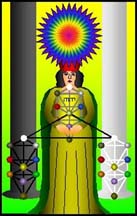 Lamed:
6>7
Lamed:
6>7
Path #20 - "The twentieth path is called the consciousness of will because it is the pattern of all that is formed. By this mode of consciousness one may know the actuality of the primordial wisdom."
The Hebrew letter, Lamed, is said to depict a snake uncoiled, symbolizing the unleashed force of Individual will. The task of this path is to direct this Individual, Tiphareth will to the Netzach level of the personality's instinctual emotions. With the light of their Individual will, the initiate illuminates the whole of their emotional nature, transforming and setting aright everything that does not reflect this will with clarity.
The essence of Tiphareth (i.e., the holy powers descending from Kether) is equilibrium or balance, so this willful act of self-transformation seeks to create balance within the realm of the personal Netzach. This conscious act of creating balance mimics the creativity of the "primordial wisdom" (Kether) and it is this to which the "32 Paths" text refers when it says: "By this mode of consciousness one may know the actuality of the primordial wisdom."
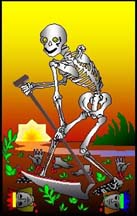 Nun:
6>8
Nun:
6>8
Path #22 - "The twenty-second path is called the faithful consciousness because, through it, the spiritual powers are increased. All dwellers on earth 'abide in its shadow.'"
With the work of the path of Nun, the Individual perspective completely fills the rational intellect, transforming and regenerating it. Every thought and every response to emotional instinct is permeated through and through with the Individual perspective. This, combined with the preceding permeation of the personal Netzach, vastly increases the initiate's spiritual (i.e., mental) powers. This transformation of the personal intellect is so radical that it resembles the death of an old self and birth of the new. The initiate cannot but look at their world through new eyes and from a new perspective.
It is an inescapable fact of the temporal universe that EVERY thing is temporary. From the personal perspective, this often brings sadness and fear, but the Individual Self understands that without this cycle of life and death, nothing would flourish. It KNOWS that the essence never dies. It KNOWS that for the essence to perfect itself and eventually return to its origin, it must pass through the cycle of life and death countless times. When this knowledge is impressed upon the rational mind by the Individual will, it frees the initiate to fully pursue their spiritual advancement without fear. In fact, it is this death of the fear-of-death that the Tarot image depicts.
In Hebrew symbolism, the fish (Nun) stands for the concept of abundance and fertility. Indeed, it is the rotting matter of dead bodies that feeds the birth of the new and assures continuity. This idea of abundance is echoed in the Genesis text corresponding to the 22nd Path:
Genesis 1:22-23 - "And Elohim blessed them, saying: 'Be fruitful and multiply, and fill the waters in the seas, and let fowl multiply in the earth.' And there was evening and there was morning, a fifth day."
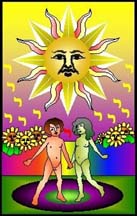 Resh:
6>9
Resh:
6>9
Path #25 - "The twenty-fifth path is called the consciousness of trial because it is the primary test by which the creator proves the compassionate (Khasidim)."
This is the path of incarnation - the "primary test" by which we are continuously perfected. The task of the path of Resh is to consciously incarnate the Individual Self within the personal self.
Resh is the first initiatory path that crosses another previously traveled path. The path it intersects is that of Mem and the Garden of Eden or lower astral veil. This is the genuine "test" for the initiate since, without the balance conferred by Tiphareth and the subsequent illumination of both Netzach and Hod, descending through the lower astral can be very unbalancing indeed.
In the Tarot image, the Individual Self is represented by the sun and the 13 descending Yods. The newly transformed Netzach and Hod are symbolized by the little girl and boy respectively. They stand, hand in hand, united in purpose and acting in unison with the sun, at the exact point where Resh intersects Mem. This specific point is one of great balance - philosophically equidistant from Tiphareth, Yesod, Netzach and Hod, simultaneously. This is the heart of the personal astral matrix itself. The immense fertility of this point is symbolized in the Tarot image by the fact of the green grass and the blooming sunflowers (i.e., solar flowers).
Bringing the Individual Self consciously into Yesod, further transforms the personality and has the effect of formalizing the Netzach and Hod transformations. Having transformed the lower or personal self in this way, the initiate is then free to turn their attention upwards and begin the process of transforming the Individual Self.
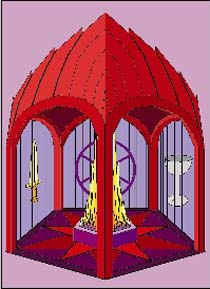 Geburah:
Sephirah #5
Geburah:
Sephirah #5
#5: I recognize the manifestation of the undeviating Justice in all the circumstances of my life.
Path #13 - "The thirteenth path is named the uniting consciousness because it is the essence of glory. It represents the completion of the true essence of the unified spiritual beings."
Geburah is where the initiate learns about and begins to wield the power of the Individual Self. This is also where, for the first time, the initiate directly perceives the "legality" or rightness of all things. The "undeviating Justice" of the universal legality is absolute and manifests in ALL the circumstances of the initiate's life. The inevitability of this fact teaches the initiate to wield their power with great care and respect, lest they burn their fingers and singe their hair.
The initiate's experiences during the process of learning about power and its use, afford a degree of completion to the Individual Self. It's akin to adolescence when the youth first learns that they actually do have their own power. At first that power is wielded selfishly and foolishly, but with time and experience, the youth matures and learns that power with is far more productive than mere power over.
The "32 Paths" text gives a wonderful clue to the work of Geburah when it's considered in the light of Paul Case's statement for Zero: "All the power that ever was or will be, is here now." This is the "true essence of the unified spiritual beings" - the power inherent in the unified or eternal NOW. In other words, in Geburah, the initiate synchronizes with the NOW and therein finds unlimited power. Projecting this power downward and manifesting it within the sequential realm, gives it material form and affords it a certain degree of completion.
The arena in which the initiate learns about their Individual power is the further transformation of Self at the personal and Individual levels.
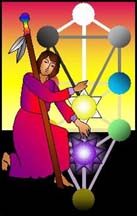 Yod:
5>6
Yod:
5>6
Path #17 - "The seventeenth path is called the consciousness of disposition. It provides faith to the compassionate (Khasidim) and clothes them with the Holy Spirit (Ruach Elohim). Within the supernals it is called the foundation of beauty (Tiphareth)."
With the path of Yod, the initiate projects the laser beam of their power upon the perfecting of the Tiphareth Individual Self. This phase of Self-transformation has to do with the direct, conscious integration of the higher influx descending from the Greater Self (Binah), into the Tiphareth Individual. The process is as the Tarot image depicts - a casting of light upon darkness. The words of the corresponding Genesis passage describe this perfectly:
Genesis 1:17-18 - "And Elohim set them [the two lights] in the firmament of the heaven to give light upon the earth, and to rule over the day and over the night, and to divide the light from the darkness."
Here we see (for the only time) Elohim "set them". This is a very concrete act that serves as a foundation for Tiphareth (in the words of the "32 Paths"). Elohim also gives a specific set of purposes to these lights and this is reflective of the Geburian power and legality.
The influx from the Greater Self that descends into the Individual Self, is the "Holy Spirit" mentioned in the "32 Paths" text. At the level of Tiphareth, this influx or "breath of Elohim" is perceived as a "clothing" of light.
It's important to understand that in the "32 Paths", the term 'Khasidim' ("compassionate") is a code word for the initiate - the upward traveler who seeks enlightenment. When the initiate consciously projects the aspect of the Ruach Elohim that descends from Geburah unto Tiphareth, a sense of faith in the rightness of EVERY thing, infuses the initiate's consciousness. This has to do with the perception of legality and the recognition of the fact that the undeviating justice does indeed manifest itself in ALL circumstances.
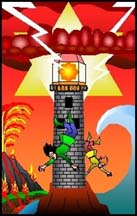 Peh:
5>8
Peh:
5>8
Path #21 - "The twenty-first path is called the consciousness of the desired-which-fulfills because it receives the divine influence which flows into it as a result of the blessing it confers upon all that exists."
Peh is the path that connects Geburah - the terminus of the mental "plan of the primordial" (Aleph) - with Hod - the terminus of the lower astral manifestation of this "plan" (Mem). In essence, the Geburah aspect of the Individual Self is the immediate product of the mental "plan" and when it consciously descends into Hod (the direct product of the lower astral "plan") a cathartic transformation of one's cherished belief systems takes place. This is because the perspective of the Geburah Individual includes the perception of legality and immense power, and this combination shatters any remaining illusions or delusions arising from the astral and physical experience.
In the Tarot image, the descending influx from Geburah is symbolized by the lightning flash that strikes the crown of the tower. Everything inhabiting this mental tower of cherished delusions is forced to either learn to fly or be dashed upon the rocks and destroyed. Yet in the "32 Paths" text, this seemingly destructive event is counted as "the blessing it confers upon all that exists.
The title of this path ("the desired which fulfills") is interesting. On the one hand, it's a warning similar to "be careful what you wish for". This has great relevance since at the Geburah level of attainment, what one wishes for WILL come to pass and great care must be exercised.
On the other hand, it's also a deeply kabbalistic statement pertaining to the descent of the "substance of the unity" along the left pillar; specifically its descent from the upper-Yetziratic, mental "plan" (Aleph) to the level of the lower-Yetziratic astral "plan" (Mem). The corresponding Genesis passage (1:21) describes this blessing with the words, "and Elohim saw that it was good."
An alternate translation of the title for this path is "the desired and the required" - two separate needs. Again this speaks of the sustenance provided by the mental level unto the astral level, but it's also a statement of what the initiate must accomplish with the path of Peh - namely, to differentiate between that which is merely desired and that which is a requirement, between what's essential and what's superfluous within the rational intellect. This is a willful act of paring away the irrelevant and illuminating the relative darkness of the personal self.
When this Geburian transformation of the Individual Self is complete, a new relationship with the NOW and with power emerges and the initiate rises to Gedulah, the realm of "Loving Kindness" and "Mercy".
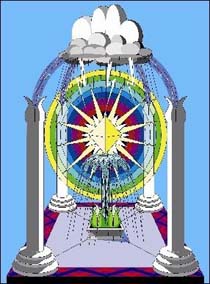 Gedulah:
Sephirah #4
Gedulah:
Sephirah #4
#4: From the exhaustless riches of the Limitless Substance, I draw all things needful, both spiritual and material.
Path #10 - "The tenth path is called the resplendent consciousness because it is exalted above every head and sits on the throne of Binah. It is illuminated with the splendor of all the lights and it causes an influence to flow forth from the Prince of Countenances."
Gedulah is the highest Sephirah of the Individual Self and stands at the border of the Abyss between our sequential, temporal realm and the non-sequential realm of eternity (i.e., the "Supernal realm"). In effect, it's the initiate's jumping off point in their journey across the Abyss. As such, the experience of Gedulah is all about the nature of sequence, for this knowledge is what carries the initiate through the veil of Aleph and across the Abyss to the veil of Shin.
Gedulah and Geburah represent the two poles of sequence - similarity and difference, respectively. As the Unity descends into Yetzirah, causing the realm of sequence, the first degree of sequence to emerge is similarity or alikeness, where sequence is a matter of attraction. This is Gedulah, "loving kindness", the force that draws all things together. Here, sequence is expressed as degrees of similarity.
Born from similarity, the second and opposite pole of sequence to emerge is that of difference, where sequence becomes a matter of attraction AND repulsion. This is Geburah, "might" or "power" (also known as Pachad or "fear"). This is the force that pushes all things that are not similar, apart. This sets the stage for a more complex sort of sequence - time-space.
In Geburah, the initiate encountered the vast power inherent to the temporal NOW, but in Gedulah, the initiate experiences the temporal NOW directly and to its fullest. Thus the "power" found in Gedulah (i.e., loving kindness) is infinitely greater than what the initiate experienced in Geburah. However, the experience of this greater power is limited only to those who have thoroughly learned the Geburah lesson about the superiority of power with versus the inferiority of power over.
In Gedulah, the temporal NOW is defined as the infinitely finite point that divides past from future. It is toward the realization and experience of this NOW point that the initiate strives in Gedulah. Once attained, this experience reveals an entirely new, completely objective perspective on the universe. It's also a perspective that is naturally and unavoidably imbued with a loving kindness for EVERY thing.
The temporal NOW point is the sequential reflection of what Paul Case said about the Zero: "All the power that ever was or will be is here NOW". It's the point at which the "splendor of the Unity" enters into the sequential realm and provides "ALL things needful, both spiritual and material." This "splendor" gives birth to the path of Aleph and the "plan of the primordial". This "plan", emanated by Gedulah, is what the "32 Paths" text refers to with the words, "and it causes an influence to flow forth from the Prince of Countenances."
Because of Gedulah's position at the crux of time (the NOW point) it is the seat of "prophesies that seers behold in visions" (see Gimel, Path #12). In other words, from the Gedulah perspective, time is an open book. Among the implications of this for the initiate is included the attainment of a specific sort of inclusive temporal perspective upon the sequential universe. This deepens still further the perception and understanding of the universal legality and transforms it into a true faculty that the initiate must then employ in their transformation of the Individual Self.
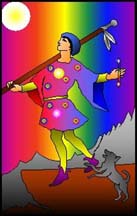 Aleph:
4>5
Aleph:
4>5
Path #8 - "The eighth path is called the perfect consciousness because it is the plan of the primordial. It has no root where it can abide except in the hidden chambers of majesty (Gedulah) from which its own secret essence emanates."
In the Genesis sequence of creation, Aleph marks the first time that Elohim "makes", indicating the World of Yetzirah for which Aleph provides the "plan".
Genesis 1:7 - "And Elohim made the firmament, and divided the waters which were under the firmament from the waters which were above the firmament, and it was so."
Aleph, the "plan of the primordial", is this "firmament". The Hebrew word translated (most often) as "firmament" comes from the root verb 'resh-qooph-ayin' which means alternately, "to stamp, tread down, beat into thin plates" or "to stretch out, expand and spread". The second definition, indicating an expanse, defines the Abyss (i.e., the "hidden chambers of Gedulah") which, in the symbolism of the Hebrew Tree, lies directly above the path of Aleph. The first definition however, defines the true nature of Aleph itself - the Abyssal expanse, "beaten into a thin plate". This "thin plate" is the veil which seems to separate the upward gazing initiate from the Supernal realm. This veil and the Abyss it shrouds are what separate Yetzirah from Briah, "the waters which were under the firmament from the waters which were above the firmament".
The Tarot image depicts this "plan" as the descent of an innocent spirit of loving kindness, into the realm of differentiating experience. This is the highest aspect of the Individual Self who, willingly and with full awareness of the consequences, enters into the process that brings involvement in the wheel of incarnation. This is not a blind foolishness; rather, it's a willingness based in full awareness and focused completely upon manifesting the spirit of loving kindness, come what may.
The task of the initiate is to infuse their Geburah awareness with their Gedulah awareness. This integrates the spirit of loving kindness and its unlimited storehouse of NOW power into the Geburah manifestation of power, exponentially increasing and purifying it.
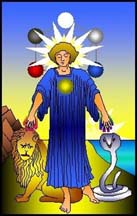 Teth:
4>6
Teth:
4>6
Path #11 - "The eleventh path is called the scintillating consciousness because it is the essence of the veil which is placed before the ordered arrangement of the powers. Who walks this way acquires a special dignity - he can stand face to face before the cause of causes."
This path completes the triangle of the integrated Individual Self. All of the Individual's powers come together to act in unison and perfect equilibrium with this descent into Tiphareth. In the words of the "32 Paths", this completion confers the ability to "stand face to face before the cause of causes". In other words, the integrated Individual Self looks directly up to Kether, yet there is still a space between - the Abyss which keeps us face-to-face instead at-one-with. This face-to-face experience gives the integrated Individual a glimpse of the Kethric influx. The sense of self-assurance this produces within the Individual and personal levels of Self is aptly depicted by the Tarot image. Here we see the integrated Individual in perfect sync with the objective reality and functioning in complete power with it. Such an Individual works with the universal legality, giving to the effort the fullness of their conjoined Gedulah-Geburah power.
The Hebrew letter Teth is said to depict a coiled serpent. This, along with the association of Teth with the sign of Leo (the lion), indicate the immense reserve of unleashed potential available to the integrated Individual. This "scintillating consciousness" is the essence of Aleph (the "veil which is placed before the ordered arrangement of the powers").
The task of Teth is for the initiate to consciously cast their "scintillating consciousness", along with all its reserve of power, into the work of perfecting the Individual Self. The aim is to transform the Individuality into a clear expression of the integrated Individual's perception of the Kethric influx. This completes the transformation of the Individual Self, below the Abyss.
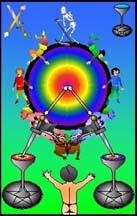 Kaph:
4>7
Kaph:
4>7
Path #18 - "The eighteenth path is called the consciousness of the house of influence. From its inmost center flow the Arcanum and veiled ideas, which "abide in its shadow"; thus is there union with the inmost substance of the cause of causes."
With the path of Kaph, the initiate now turns the same Gedulah force upon their personal self and, by extension, upon their mundane life circumstance. This integrates the integrated Individuality still further, into the denser levels of personal self.
The "32 Paths" text describes this as a descent of "the Arcanum and veiled ideas" from Gedulah, into Netzach which "abides in the shadow" (i.e., exists below solar Tiphareth). At the level of Netzach, the universal legality as it's perceived in Gedulah, takes on the astral form of "Arcanum and veiled ideas". In other words, the Netzach perception of legality is normally veiled with astral symbol, represented in the Tarot image as the common conception of fortune or luck-of-the-draw.
The initiate however, brings a different, more inclusive perspective to Netzach and the realm of instinctual emotions as they perform the task of Kaph. Mind you, the initiate's Netzach has already been transformed by prior work, so it's not like the average person's Netzach. When the integrated Individual descends by the path of Kaph into Netzach, they infuse their instinctual emotions with the Gedulah perspective and power. This transforms the entire emotional composition of the initiate into a perfect reflection of the Individual influx of light. This transformation immediately passes from Netzach to Hod and on to Yesod and Malkuth, bringing the whole structure of the Individual and personal Self into a state of integrated equilibrium. This so deepens the "union with the inmost substance of the cause of causes", that the initiate can then begin their penetration of the veil and crossing of the Abyss.
Binah: Sephirah #3
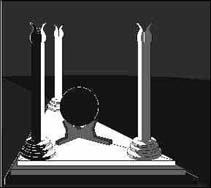
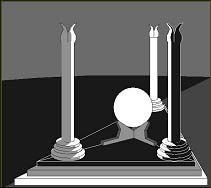
#3: Filled with Understanding of its perfect law, I am guided, moment by moment, along the path of liberation.
Path #7 - "The seventh path is the hidden consciousness because it is the radiance that illuminates all the powers of the mind which are seen with the eye of the intellect and through the contemplation of truth."
Genesis 1:6 -"And Elohim said: 'Let there be a firmament in the midst of the waters, and let it divide the waters from the waters.' "
With Aleph, Elohim "made" the "firmament" (the compressed, condensed veil), but with Binah, Elohim says "let there be a firmament". In other words, this is a statement of potential and intention, not of "making" or manifesting. Furthermore, it speaks of the potential for sequence (let it divide the waters from the waters) within a unified, non-sequential realm (in the midst of the waters).
The true Binah stands on the opposite side of the Abyss from Gedulah. It is the realm of undifferentiated, unsequentialized potential. Of course, hand in hand with this potential is also their inevitable realization or manifestation, but at the level of Binah proper, they exist only as unlimited potential. Gedulah on the other hand, is the point (NOW) where those potentials descend into the realm of sequence and begin their process of realization.
The Abyss is purely mental and is composed solely of our inability as sequentialized units of consciousness, to comprehend non-sequentiality. The crossing of this Abyss is therefore a matter of Understanding non-sequentiality. For the ascending initiate, Binah serves as the immediate goal of the crossing. It is, so to speak, the gateway to eternity.
As the initiate gazes toward the Abyss, Binah appears dark. Its non-sequential light is incomprehensible and therefore invisible to the Gedulah Individual. This is Binah as "Dark Sterile Mother". Yet when the initiate crosses the Abyss and experiences Binah first hand, it grows steadily brighter as Understanding increases and becomes the "Bright Fertile Mother". This is the "hidden" "radiance" mentioned in the "32 Paths" text.
Binah is where the eternal mental body resides. This is the Greater Self which projects its potential into Yetzirah and the realm of sequence, creating temporal mental bodies or Individual Selves. It is the direct causal agent of the Individual Self. For the ascending initiate, reaching Binah means merging with one's own Greater Self. In fact, it is one's own Greater Self that provides the constant guidance mentioned in Paul Case's statement.
The emanation of the Greater Self into the sequentialized Individual is what, in the words of the "32 Paths", "illuminates all the powers of the mind which are seen with the eye of the intellect and through the contemplation of truth." Once the initiate reaches across the Abyss and arrives at Binah, they must begin the work of consciously emanating the non-sequential light of the Greater Self into the lower levels of Self.
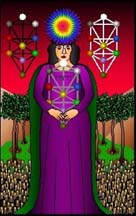 Daleth:
3>5
Daleth:
3>5
Path #14 - "The fourteenth path is called the luminous consciousness because it is the essence of the Chashmal ["speaking silence"] which is the instructor in the secret foundations of holiness and their stages of preparation."
The key to understanding this "32 Paths" description is the Hebrew word Chashmal (cheth-shin-mem-lamed). Most often it's translated as "brilliant flame", "electrum" or "amber", but in the Talmudic tradition pertinent to kabbalah, it's said to be a special joining of two words: "speaking" (mal) and "silence" (chash). As a kabbalistic term, it refers to Shin (connecting Chokmah to Binah) which was created from the "Marvelous Light" (Chokmah) and in turn gave birth to the "Arafel" (darkness) or Binah. Thus the Chashmal is a dynamic, fiery thing because of the tension created by this opposition of "speaking" and "silence". It's this flow of duality emanating from Chokmah that creates non-sequential potential (Binah) out of Unity.
With the path of Daleth, we see the dualistic essence of this dynamic Chashmal, emanated into the sequential realm and given form as infinite variety. The Tarot image expresses this as the workings of Nature herself, which is quite apt considering that Daleth is emanated by Binah, the receptacle of the "substance of the unity".
The Chashmal is the root of the universal legality, expressed in the "32 Paths" test by the words, "the instructor in the secret foundations of holiness and their stages of preparation." Universal legality is what determines the form of EVERY thing, be it potential or actual. In Binah, we see this legality in its barest, most rudimentary non-sequential form and with the emanation of Daleth we see it become sequentialized.
Franz Bardon's truly magical kabbalistic speech, which relies upon the magical manipulation of this stage of the descending legality, is therefore attributed to the path of Daleth. Kabbalistic speech consciously employs the same "laws" that Nature follows.
The specific work of the path Daleth will vary for each initiate, but in every case it involves the integration of the Greater Self's perspective into every action and every exercise of one's Individual power. Thus every one of the initiate's actions comes to perfectly reflect and manifest the Universal legality.
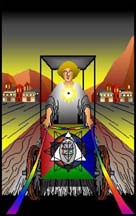 Cheth:
3>6
Cheth:
3>6
Path #9 - "The ninth path is called the pure consciousness because it purifies the essence of the Sephirot. It provides and adapts the design of their patterns and establishes their unity. They remain united, without diminution or division."
This is the primary avenue by which the Greater Self fills each of its Individualized emanations.
As the non-sequential Greater Self descends into the realm of sequence, its essence, which is unified in Binah, splits into countless Individual manifestations, each of which expresses a part of the Greater's unified wholeness. Yet simultaneously, each part remains forever connected to the Greater's wholeness. The Greater's awareness of each of its sequential parts is never split and it remains completely and fully aware of all of its parts simultaneously. Only the parts themselves ever forget the Greater level of Self. This is what the "32 Paths" text is trying to say with, "It provides and adapts the design of their patterns and establishes their unity. They remain united, without diminution or division."
This then, is the initiate's work with the path Cheth - to manifest the non-sequential Greater level of Self-awareness within their own familiar sequentialized Individual Self-awareness. The Tarot image of the Chariot, when placed upon the Hebrew Tree, accurately depicts this process.
The Chariot image illustrates the relationship between consciousness and time (i.e., sequence). Consciousness ALWAYS occupies a bubble of NOW-ness, shown here as the confining chariot. The charioteer represents the Greater Self after it's been Individualized and adorned with specific form, faculties, traits, etc. Behind this bubble of NOW-ness, lies the temporal past and above the surface of the two-dimensional card, lies the temporal future, yet to take form. No matter which direction the chariot moves, the charioteer ALWAYS exists within their bubble of NOW-ness.
With the work of Cheth, the initiate consciously fills their Individual Self with their Greater awareness and consciously picks up the reins of their chariot of NOW-ness and begins to consciously drive it as their Greater Self.
This begins a long temporal process of integrating the Greater Self level of awareness into EVERY aspect of one's life. Or, to use the "32 Paths" symbolism, the initiate "purifies the essence of the Sephirot."
Chokmah: Sephirah #2
#2: Through me its unfailing Wisdom takes form in thought and word.
Path #3 - "The third path is called the sanctifying consciousness. It is the foundation of primordial wisdom and is called "enduring faith [Amen]", and its roots are truth [Amen]. It is the father of trust [Amen], from which the power of faith [Amen] emanates."
Chokmah exists beyond the ken of images and symbols, which explains the lack of a Temple image. This is the realm where "speaking" (Paul Case's "word") and "silence" (Paul Case's "thought") - the components of the Chashmal - are still united and exist in a purely potential state.
The author of the "32 Paths" plays with the various meanings of the word "Amen" (aleph-mem-nun) here, perhaps in an attempt to convey some sense of the dynamic between thought and word, between essence and manifestation, force and form, etc. This dynamic permeates Chokmah, yet in a subdued unified state, hence the common attribution of a dove gray color for Chokmah.
With the attainment of Binah, the initiate gained Understanding. Through the process of applying this nascent Understanding to every circumstance of their life, the initiate's Understanding matures into Wisdom. Understanding is situational - it requires an object to focus upon. Wisdom however, is a continuous state that exists without the need for an object of focus and automatically manifests itself through the thoughts and words of the initiate. Here, the initiate not only Understands and manipulates the Universal legality, they become the legality itself.
At the level of Binah, which serves as the receiving vessel of the dynamism of the unleashed Chashmal, there exist a non-sequentially infinite number of Greater Selves, but in Chokmah, which serves as the source of the Chashmal, there is only one Greater Self. Chokmah is the Unity of infinite parts (8), distinct from Kether which is the Unity without parts (0).
The single Greater Self of Chokmah carries the seed that produces the many, just as the color gray carries the seed of both black and white yet is neither exclusively. Once the initiate attains Chokmah, they then act AS this single Greater Self.
When the initiate "stands" in Chokmah, they are faced with the choice of which of the countless Binah Greater Selves is to receive this seed. Ultimately, ALL receive the Chokmah seed simultaneously since this occurs at a non-sequential, eternal level; but for the already Individualized consciousness of the initiate, this is experienced as a binary, 'either/or' choice.
From Chokmah, the initiate, acting AS this single Greater Self, casts the seed of their Wisdom into first their own Binah Greater Self, and then into all the rest, one by one. Unfortunately, these temporal words we must use to communicate cannot accurately describe a non-sequential event - they always imply the passage of time and sequence. Nonetheless, it must be understood that EVERY thing that transpires above the Abyss occurs without sequence and outside of time.
The corresponding Genesis passage tries to convey this concept of non-sequential simultaneity.
Genesis 1:3 -"And Elohim said, 'Let there be light', and there be light."
In other words, in Chokmah, cause and effect occur in perfect unison, without sequence. Such is the power that the initiate of Chokmah possesses and must wield upon Self.
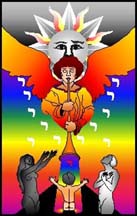 Shin:
2>3
Shin:
2>3
Path #24 - "The twenty-fourth path is called the imaginative consciousness because it provides an image to all created things that have an appearance, in a form fitting to each."
Shin, the Mother Letter of Fire, IS the Chashmal. This is the supernal root or template of the mental "plan of the primordial" (Aleph) and the astral "plan" (Mem). It is the seed which provides the archetypal "image to all created things that have an appearance, in a form fitting to each." With Shin, the initiate, acting AS the single Chokmah Greater Self, consciously implants this seed within the Bright Fertile Mother (Binah). Initially, the initiate's own Binah Greater Self is thus fertilized, but ultimately, ALL the Binah Greater Selves are fertilized.
As the Tarot image illustrates, this fertilization (pictured as a non-verbal sound vibration emanating from the Archangel's trumpet) brings about the birth of a new life amid the old.
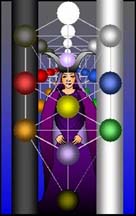 Gimel:
2>4
Gimel:
2>4
Path #12 - "The twelfth path is called the transparent consciousness because it is the substance of that phase of majesty (Gedulah) which is called revelation (khazkhazit). It is the source of prophesies that seers behold in visions."
The word "khazkhazit" was coined by the author of the "Book of Contemplation" and is translated variously as "visualizer", "gazing-glass", etc. All of these translations equate to revelation and divine vision. Yet here, quite subtly, is the veil of the Abyss, for revelation is a channeled and guarded thing - it is received as though through a gazing-glass. This veil defines the separation between Briah (the realm of pure thought or idea) and Yetzirah (the realm of images that symbolize pure thought).
The emanation of Gimel from Chokmah to Gedulah is called "transparent" because it represents the descent of pure thought into the realm of images. Franz Bardon's magical evocation is attributed to this path because the basis of true evocation is the art of working with the pure thought that underlies all images and forms.
The initiate who consciously casts the seed of the single Chokmah Greater Self into their own Individual Gedulah, becomes a master of images and of the temporal NOW itself, perfectly manifesting Loving Kindness through their every thought, word and deed.
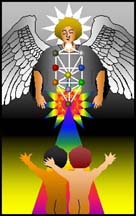 Zayin:
2>6
Zayin:
2>6
Path #6 - "The sixth path is called the mediating consciousness because through it the emanation of atziluthic influence is increased. It causes that influence to flow unto all those so blessed as to be united to its essence."
The "atziluthic influence" mentioned in the "32 Paths" text refers to the path Beth which descends from Kether directly into Tiphareth, carrying with it the "holy powers". The entry of Chokmah into Tiphareth via the path of Zayin, multiplies this Kethric influx within Tiphareth. The transformation which ensues because of this multiplication is what empowers the initiate's ascent to Kether.
As the Tarot image implies, the work of this path is the conscious integration of the single Chokmah Greater Self into the initiate's own Individual and personal Self. The radiant being that results from this integration of the supernal into the mundane is indeed a blessing to the world.
Kether: Sephirah #1
#1: I am a center of expression for the Primal Will-to-Good which eternally creates and sustains the universe.
Path #1 -"The first path is called the mystical consciousness, the highest crown (Kether). It is the light of the primordial principle which has no beginning; and it is the primal glory. No created being can attain to its essence."
As I said above, Kether is the Unity without parts. It is the completely integrated whole that, in and of itself, experiences no separation into parts. For the Kethric consciousness, ALL is simply Self. In Kether, there is no differentiation into beginning, middle and end; no binary choice even. This is expressed in the corresponding Genesis passage:
Genesis 1:1 - "In the beginning, Elohim created the heaven and the earth."
In other words, from the outset, so to speak, EVERY thing has existed within Kether - the heaven AND the earth, simultaneously.
The initiate who attains to full cognizance of Kether becomes at-one-with EVERY thing; every who, what, where, when and why. For such a one, cause and effect occur simultaneously and life becomes a matter of simply BEing instead of willing or desiring or making happen.
Paul Case's statement best describes the initiate's work: one becomes a conscious center of expression for the Primal Will-to-Good, and actively participates in the eternal creating and sustaining of the universe.
The "32 Paths" proviso that "no created being can attain to its essence" is a VERY deep mystical statement. The "essence" of Kether is the Ayin, commonly translated as "nothingness". The Ayin is so utterly foreign to creatures that "exist" or have BEing, that it is impossible for us to even begin to comprehend this "realm". Our words cannot even begin to describe it. The only consciousness capable of comprehending the Ayin is Kether: The One Self, the Unity of ALL BEing. In other words, no created being can attain to the Ayin - only the creator of being can do so. Which is another way of saying that unity with Kether brings the initiate their first perception of this essence.
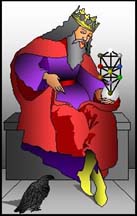 Heh:
1>2
Heh:
1>2
Path #2 - "The second path is that of the illuminating consciousness. It is the crown (Kether) of creation (Briah), the splendor of the unity, like unto that which "exalts itself as the head over all." The masters of kabbalah call it the second glory."
Here we see the Kethric Light emanating down to Chokmah. This emanation of Light "crowns" Briah. In other words, it stands above the Briatic World of Chokmah-Binah. This descending illumination carries the "splendor" aspect of Kether, the Primal Glory. Therefore, Heh is called the "second glory" and is depicted in the Tarot as an Emperor who "exalts [him]self as the head over all." The Emperor may wear and personify the power that the Crown confers, but he is not the Crown itself.
Heh represents the "first" non-sequential act of creation (Briah) which is/was/will-be a matter of Elohim turning Its attention "downward":
Genesis 1:2 - "And the earth was unformed and void, and darkness was upon the face of the deep; and the spirit of Elohim hovered over the face of the waters."
Here, Elohim "does" nothing more than take notice of the state of potential and "hover over" attentively. Yet this divine attention is what ultimately sustains the universe since it provides the mental pattern for all that follows.
With Heh, the initiate consciously integrates this mental pattern which sustains all created things, into the single Chokmah Greater Self.
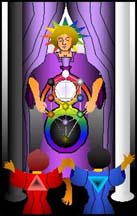 Vav:
1>3
Vav:
1>3
Path #5 - "The fifth path is called the root consciousness because it is the substance of the unity, joining itself to that understanding (Binah) which itself emanates from within the province of primordial wisdom."
With Vav, Kether impregnates the infinite potential of Binah with the Light of its substance. The corresponding Genesis passage gives insight into the nature of this "substance".
Genesis 1:4 - "And Elohim divided the light from the darkness."
Thus we see that this "substance" has to do with dividing, which in this case is the same as multiplying since we have divided what was formerly one thing, into two things. In other words, this is the beginning of the potential for an infinite variety of distinct expressions of the One Thing. It's this influx of the "substance of the unity" that establishes the pillar of severity or form.
In the Tarot, this is symbolized by the Hierophant who philosophically divides the light from the darkness and passes on his own Understanding to those of lesser understanding.
The initiate's task with the path of Vav is to consciously cast their seed of Kethric "substance" upon the infinite potential within their own Greater Self and upon all the other Greater Selves resident in Binah.
 Beth:
1>6
Beth:
1>6
Path #4 - "The fourth path is named the overflowing consciousness because from it, emanate all the holy powers, all the most ethereal emanations with the most sublime essences: they emanate one from the other through the power of the primordial emanator."
The Hebrew letter name 'Beth' means "house" in English. As the first letter in the Torah, it is said to house all the letters that follow. In other words, it contains within itself all the "holy powers" and conveys them directly to the Individual (Tiphareth).
Beth is the only path on the Tree that crosses two horizontal paths; the path Shin between Chokmah and Binah, and the path Aleph between Gedulah and Geburah. It pierces both the supernal veil of Shin and the Abyssal veil of Aleph, and comprehends both levels of the "plan". It also establishes the middle pillar of equilibrium, upon which are found the Sephirot pertaining to the levels of Self (Supernal Kether, Individual Tiphareth, personal Yesod and material Malkuth) - the "holy powers of the unity".
The initiate's work of the path Beth is to consciously bring down the whole of Kether into the Individual Self. Once brought directly into Tiphareth, the Kethric Light permeates every other level of Self and every other Sephirot of its own accord; or as the "32 Paths" states it, "they (the "holy powers") emanate one from the other through the power of the primordial emanator (Kether)." In other words, the Tiphareth thus illuminated becomes like a radiant sun which casts its light in every direction, giving life and sustenance to all.
This fills the initiate with the constant Kethric awareness of the Unity at the Individual and personal levels of Self.
Bibliography
Case, Paul Foster. The Book of Tokens, (L.A., CA: B.O.T.A., 1978).
The Tarot, (Richmond, VA: Macoy, 1947).
Clark, Rawn. A Path To Understanding, (1997) http://www.ABardonCompanion.com
The Eight Temples Meditation Project, (Paris, France: J. Hutchinson, 2002).
Davidson, Benjamin. The Analytical Hebrew and Chaldee Lexicon, (London: Bagster, 1970).
Eshelman, James (Trans.) The 32 Paths of Wisdom, (L.A., CA: C.O.T., 1994).
Kaplan, Aryeh. Sefer Yetzirah: The Book of Creation, (York Beach, ME: Weiser, 1990).
Scholem, Gershom. Origins of the Kabbalah, (Princeton, NJ: Princeton, 1990).
Verman, Mark. The Books of Contemplation, (Albany, NY: S.U.N.Y.,
1992).
Notes
[1] See Kaplan, Sefer Yetzirah, p.7, n.1.
[2] See Verman, The Books of Contemplation, p.71, n.103.
[3] I highly recommend Verman's The Books of Contemplation for a very scholarly and insightful examination of the writings that emerged from this group of kabbalists.
[4] See Kaplan, Sefer Yetzirah, p.28. In "Figure 3" he designates this Tree as "According to the older kabbalists."
[5] The images themselves are my own creation, suited to the Hebrew Tree and the "32 Paths of Wisdom".
[6] The Eight Temples Meditation Projectby Rawn Clark. Also available online at http://www.ABardonCompanion.com/